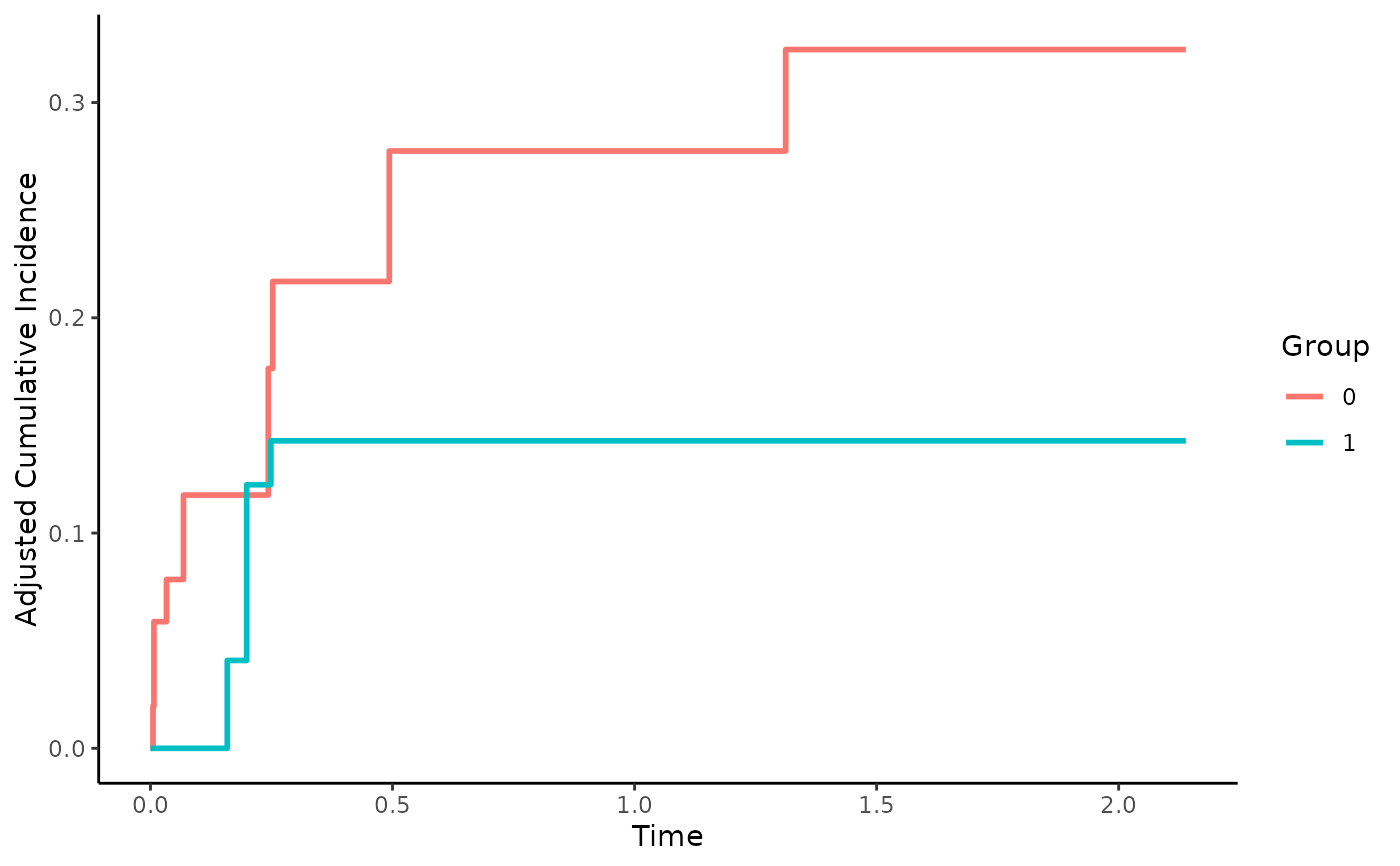
Using Propensity-Score Matching to Calculate Adjusted CIFs
cif_matching.RdThis page explains the details of estimating adjusted cumulative incidence functions using propensity-score matching in a competing risks setting (method="matching" in the adjustedcif function). All regular arguments of the adjustedcif function can be used. Additionally, the treatment_model argument has to be specified in the adjustedcif call. Further arguments specific to this method are listed below.
Arguments
- treatment_model
[required] Must be either a model object with
variableas response variable or a vector of previously estimated propensity scores.- gtol
Tolerance at which estimated treatment assignment probabilities are truncated. Every propensity score bigger than 1 -
gtolis set to 1 -gtoland every propensity score smaller thangtolis set togtol. Useful when there are extreme propensity scores close to 0 or 1. Defaults to 0.001,- ...
Further arguments passed to the
Matchfunction of the Matching Package.
Details
Type of Adjustment: Requires a model describing the treatment assignment mechanism. This must be either a
glmobject or a vector of propensity scores.Doubly-Robust: Estimates are not Doubly-Robust.
Categorical groups: Only two groups in
variableare allowed. Must be a factor variable with exactly two levels.Approximate Variance: Calculations to approximate the variance and confidence intervals are currently not available. Bootstrapping can still be used to estimate the confidence intervals (see
?adjustedcif).Allowed Time Values: Allows both continuous and integer time.
Bounded Estimates: Estimates are guaranteed to be bounded in the 0 to 1 probability range.
Monotone Function: Estimates are guaranteed to be monotone.
Dependencies: This method relies on both the Matching and the cmprsk packages.
Using the estimated propensity score, the individual observations in the dataset are matched to each other creating a new dataset in which the covariate distributions are balanced in respect to the two groups defined by variable. A simple Aalen-Johansen estimator is then used to calculate the confounder-adjusted CIFs. This corresponds to the method described in Austin & Fine (2019). Details on the algorithm used for matching can be found in the documentation of the Matching package.
Simulation results showed that this specific implementation of this method is the least efficient method contained in this R-Package. While it does produce unbiased estimates, the variation in these estimates is very high. We strongly suggest using one of the other methods implemented here.
Value
Adds the following additional objects to the output of the adjustedcif function:
match_object: The object creates using theMatchfunction.cuminc_object: Thecumincobject fit on the matched data.
References
Peter C. Austin and Jason P. Fine (2019). "Propensity-Score Matching with Competing Risks in Survival Analysis". In: Statistics in Medicine 38, pp. 751-777
Examples
library(adjustedCurves)
library(survival)
if (requireNamespace("Matching")) {
library(Matching)
set.seed(42)
# simulate some data as example
sim_dat <- sim_confounded_crisk(n=50, max_t=5)
sim_dat$group <- as.factor(sim_dat$group)
# estimate treatment assignment model
glm_mod <- glm(group ~ x1 + x2 + x4 + x6, data=sim_dat, family="binomial")
# calculate adjusted CIFs
adjcif <- adjustedcif(data=sim_dat,
variable="group",
ev_time="time",
event="event",
cause=1,
method="matching",
treatment_model=glm_mod)
plot(adjcif)
# Alternatively, supply the propensity score directly
# Here we use the logistic regression to calculate it, so we get
# exactly the same result. The propensity score can be calculated in
# any other way in practice, allowing flexibility
ps_score <- glm_mod$fitted.values
adjcif <- adjustedcif(data=sim_dat,
variable="group",
ev_time="time",
event="event",
cause=1,
method="matching",
treatment_model=ps_score)
# plot the curves
plot(adjcif)
}
#> Loading required namespace: Matching
#> Loading required package: MASS
#> ##
#> ## Matching (Version 4.10-15, Build Date: 2024-10-14)
#> ## See https://www.jsekhon.com for additional documentation.
#> ## Please cite software as:
#> ## Jasjeet S. Sekhon. 2011. ``Multivariate and Propensity Score Matching
#> ## Software with Automated Balance Optimization: The Matching package for R.''
#> ## Journal of Statistical Software, 42(7): 1-52.
#> ##
